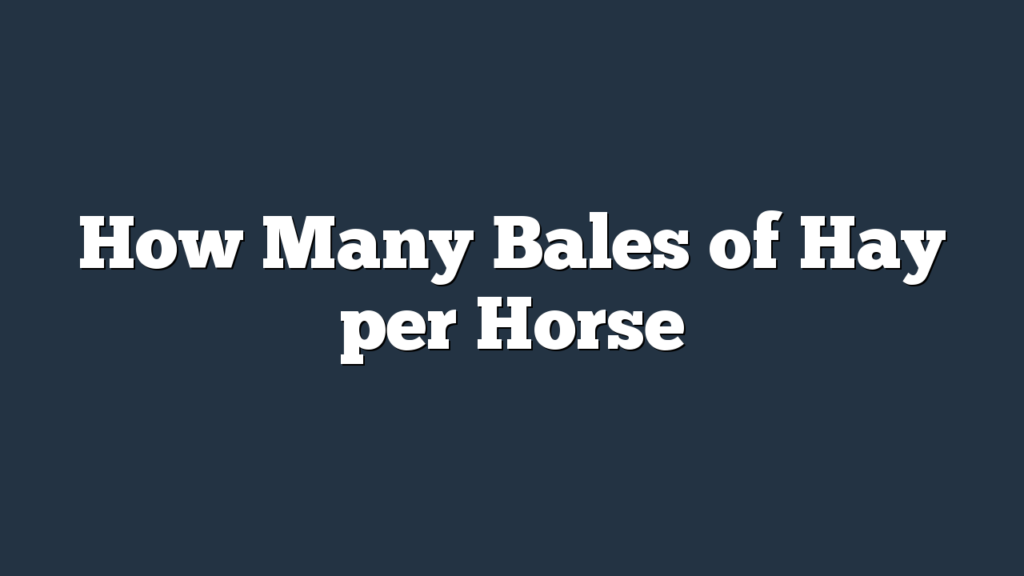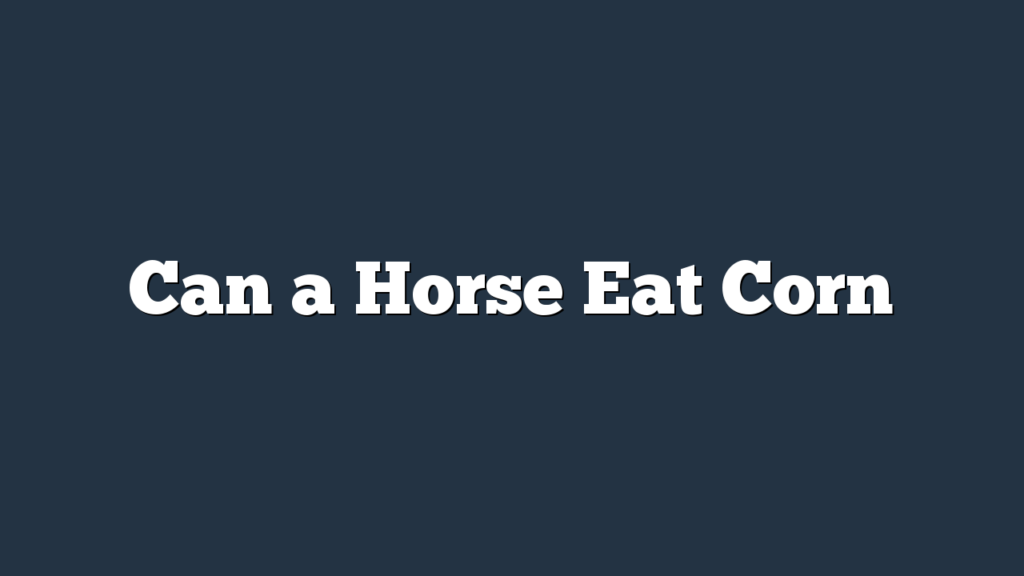Do you know how many bales of hay your horse needs?
Understanding the amount of hay required for your horse is crucial for their health and well-being. Factors like weight, activity level, and weather conditions can affect their hay consumption.
In this article, we will discuss recommended hay rations for different types of horses, how to adjust intake during winter, and the impact of hay quality on feeding amounts.
Stay informed and ensure your horse gets the right amount of hay.
Importance of Knowing Hay Requirements
Knowing the exact hay requirements for your horse is essential for providing the proper nutrition and ensuring their overall health and well-being. The importance of hay quality can’t be overstated. High-quality hay is rich in nutrients and essential for your horse’s growth, development, and performance. It provides a source of energy, protein, and fiber that’s vital for their digestive system to function properly. Poor quality hay, on the other hand, lacks essential nutrients and can lead to deficiencies and health issues in your horse.
In addition to hay quality, proper hay storage and preservation are equally important. Hay should be stored in a dry, well-ventilated area to prevent mold and moisture buildup. Moldy hay can cause respiratory problems and other health issues for your horse. It’s also important to protect hay from pests, such as rodents and insects, as they can contaminate the hay and make it unsafe for consumption.
By knowing the hay requirements for your horse and ensuring the quality and proper storage of hay, you’re taking proactive steps to maintain their health and well-being. A well-nourished horse is more likely to have a strong immune system, maintain a healthy weight, and perform at their best.
Factors Affecting Hay Consumption
To accurately determine the number of bales of hay your horse will consume, it’s important to consider various factors that can affect their hay consumption. Factors determining intake can vary from horse to horse, and understanding these factors will help you provide the appropriate amount of hay for your equine companion.
One of the main factors affecting hay consumption is the size and weight of your horse. Larger horses generally require more hay than smaller ones. Additionally, horses in heavy work or underweight may have a higher hay intake compared to horses at a healthy weight or in light work.
Another factor to consider is the quality of the hay. Horses tend to eat more of lower quality hay, as they need to consume larger quantities to meet their nutritional needs. On the other hand, horses may eat less of higher quality hay, as it provides more nutrients per bite.
The environment and weather conditions also play a role in hay consumption. During colder months, horses may increase their hay intake to help maintain body temperature. In hot weather, horses may eat less hay due to decreased appetite. It’s important to adjust the amount of hay provided accordingly.
Lastly, the type and availability of pasture can affect hay consumption. Horses with access to lush, nutrient-rich pasture may eat less hay, while horses with limited or no pasture may rely more heavily on hay.
Understanding Horse Weight and Hay Intake
To understand how much hay your horse needs, it’s important to consider their weight and hay intake. Calculating the horse’s hay intake involves determining their body weight and adjusting the quantity of hay accordingly.
Calculating Horse Hay Intake
To accurately calculate how much hay your horse needs, start by determining its weight and hay intake requirements. Knowing your horse’s weight is crucial, as it will help you estimate its daily hay intake. A general guideline is that a horse should consume 1.5% to 2.5% of its body weight in hay each day. However, factors such as age, activity level, and metabolism can affect this amount. Use the table below to estimate your horse’s daily hay intake based on its weight:
| Horse Weight (lbs) | Hay Intake (lbs) |
|---|---|
| 800-1000 | 12-25 |
| 1000-1200 | 15-30 |
| 1200-1400 | 18-35 |
| 1400-1600 | 21-40 |
Adjusting Hay Quantities
You need to adjust the quantity of hay based on your horse’s weight and hay intake.
It’s important to monitor your horse’s weight gain and make necessary changes to their feeding schedule accordingly.
Horses that are underweight may require an increase in hay intake to help them put on healthy weight.
On the other hand, if your horse is overweight or prone to weight gain, you may need to reduce the amount of hay they’re given.
It’s crucial to strike a balance and provide your horse with the right amount of hay to meet their nutritional needs without causing excessive weight gain.
Regularly monitoring your horse’s weight and adjusting their hay quantities will help ensure their overall health and well-being.
Recommended Hay Rations for Idle Horses
When it comes to feeding idle horses, it’s important to consider their optimal daily hay intake. Factors such as age, weight, and breed can influence the amount of hay a horse needs.
Additionally, adjusting the hay ration based on their activity levels is crucial to ensure they maintain a healthy weight.
Optimal Daily Intake
While it is important for horses to have access to forage throughout the day, it is equally essential to consider their optimal daily hay intake. Providing horses with the right amount of hay is crucial for their overall health and well-being. To ensure optimal hay feeding, it is recommended to follow hay consumption guidelines based on the horse’s weight and activity level. Below is a table outlining the recommended daily hay rations for idle horses:
| Horse Weight (lbs) | Hay Consumption (lbs) |
|---|---|
| 900-1,100 | 15-20 |
| 1,100-1,300 | 20-25 |
| 1,300-1,500 | 25-30 |
| 1,500-1,700 | 30-35 |
| 1,700-2,000 | 35-40 |
Factors Influencing Consumption
How does the horse’s weight and activity level influence their recommended hay rations?
There are several factors that can affect a horse’s feeding patterns and the amount of hay they require. Here are some key points to consider:
- Weight: A horse’s weight plays a significant role in determining their hay intake. Heavier horses generally require more hay to meet their nutritional needs.
- Activity Level: Horses with higher activity levels, such as those in regular training or competition, may need additional hay to fuel their energy requirements.
- Metabolism: Each horse has a unique metabolism, which can also impact their hay consumption. Some horses may have a faster metabolism and require more frequent feeding.
- Health conditions: Certain health conditions, such as dental issues or digestive problems, can affect a horse’s ability to consume hay. Adjustments in feeding may be necessary to accommodate these conditions.
Considering these factors will help ensure that your horse receives the appropriate amount of hay to maintain optimal health and well-being.
Adjusting for Activity Levels
You should adjust the recommended hay rations for idle horses based on their activity levels. When horses are not engaged in regular exercise or performance activities, their hay consumption should be adjusted to prevent overfeeding and weight gain. It is important to monitor their body condition and adjust the amount of hay accordingly.
To help you understand how hay consumption can vary based on activity levels, here is a table showcasing recommended hay rations for idle horses:
| Activity Level | Hay Consumption |
|---|---|
| Light | 1-1.5% of body weight |
| Moderate | 1.5-2% of body weight |
| Heavy | 2-2.5% of body weight |
| Very Heavy | 2.5-3% of body weight |
Hay Amounts for Lightly Active Horses
For lightly active horses, determine the appropriate amount of hay using the following guidelines:
- Calculate hay portions: Start by estimating your horse’s weight. A general rule of thumb is to provide 1.5% to 2.5% of their body weight in hay per day. To calculate this, multiply your horse’s weight by 0.015 to get the lower end of the range, and by 0.025 to get the higher end. This will give you the amount of hay in pounds that your horse should consume daily.
- Adjust for weight: Keep in mind that weight can fluctuate depending on the season or other factors. If your horse is underweight, you may need to increase the amount of hay they receive. Conversely, if your horse is overweight, you might need to decrease the hay portion. Regularly monitor your horse’s body condition to ensure they maintain a healthy weight.
- Observe eating habits: Pay attention to how quickly your horse consumes their hay. If they finish it too quickly, consider using a slow feeder to help pace their eating. On the other hand, if they consistently leave hay behind, you may be providing too much.
- Consult with a professional: If you’re unsure about the appropriate hay amount for your lightly active horse, don’t hesitate to consult with a veterinarian or equine nutritionist. They can provide personalized advice based on your horse’s specific needs.
Hay Rations for Moderately Active Horses
To determine the appropriate hay rations for moderately active horses, continue estimating their weight and adjust the amount accordingly. Factors affecting digestion and the nutritional value of hay play a crucial role in determining the feeding requirements for these horses.
Moderately active horses have higher energy needs compared to lightly active ones. It’s important to consider their weight, body condition, and workload when determining their hay rations. As a general guideline, these horses should consume about 2% to 2.5% of their body weight in hay per day. However, factors such as age, breed, metabolism, and climate can influence their individual requirements.
When it comes to digestion, the quality of hay is key. Hay with higher nutritional value will provide the necessary nutrients for moderately active horses. The nutritional content of hay can vary depending on factors such as maturity at harvest, type of grass or legume, and storage conditions. It’s crucial to select hay that’s free from mold, dust, and weeds, as these can negatively impact digestion and overall health.
Hay Requirements for Intensively Active Horses
If you have a horse that’s highly active and requires a lot of energy, it’s important to understand their optimal hay consumption.
These horses have higher caloric needs, so their hay rations should be adjusted accordingly.
High-Energy Horse Diets
When feeding high-energy horse diets to intensively active horses, it’s important to consider their hay requirements. These horses have higher nutritional requirements due to their increased activity levels. Here are some key points to keep in mind:
- Quality: Make sure to provide high-quality hay that’s free from mold and dust.
- Quantity: Intensively active horses may require more hay to meet their energy needs. Monitor their body condition and adjust the amount accordingly.
- Digestibility: Choose hay that’s easily digestible to maximize nutrient absorption.
- Supplementation: Consider supplementing the horse’s diet with additional sources of energy, such as concentrates or grains, if necessary.
Optimal Hay Consumption
When feeding high-energy horse diets to intensively active horses, it is important to understand their optimal hay consumption. Proper hay management plays a crucial role in providing these horses with the necessary nutrients and energy to support their intense activity levels. By ensuring optimal feeding practices, you can help maximize their performance and overall well-being. Here is a table that outlines the recommended hay consumption for intensively active horses:
| Activity Level | Hay Consumption |
|---|---|
| Light | 1.5-2% of body weight |
| Moderate | 2-2.5% of body weight |
| Intense | 2.5-3% of body weight |
Adjusting Hay Intake for Winter Weather
To ensure your horse stays healthy and well-nourished during the winter, it’s important to consistently adjust their hay intake. Winter weather brings colder temperatures and less grazing opportunities, which means horses need more hay to maintain their body condition. Here are some tips for adjusting hay intake during the winter:
- Adjusting hay intake for older horses: Older horses have a harder time maintaining weight and staying warm during the winter. Increase their hay intake gradually to provide them with the extra calories they need. Monitor their body condition closely and consult with a veterinarian if necessary.
- Managing hay intake for pregnant mares: Pregnant mares have increased nutritional requirements, especially during the last trimester. Increase their hay intake to ensure they receive adequate nutrients for both themselves and their growing foals. Provide high-quality hay to meet their increased energy needs.
- Consider the weather conditions: Extreme cold weather can increase a horse’s calorie requirements. If the temperatures drop significantly, provide additional hay to help keep them warm. Hay fermentation in the hindgut produces heat and helps regulate their body temperature.
- Monitor body condition: Regularly assess your horse’s body condition score to ensure they’re maintaining a healthy weight. Adjust their hay intake accordingly to prevent weight loss or obesity.
Hay Quality and Its Impact on Feeding Amounts
Adjusting your horse’s hay intake based on hay quality is crucial for ensuring they receive the appropriate feeding amounts. Hay quality can vary greatly depending on factors such as maturity at harvest, storage conditions, and the presence of weeds or mold. It is important to assess the hay quality before determining the feeding amounts for your horse.
The following table illustrates how different hay qualities can affect feeding amounts:
| Hay Quality | Feeding Amounts |
|---|---|
| Excellent | Less hay needed |
| Good | Average amounts |
| Poor | More hay needed |
When hay quality is excellent, it means that the hay is nutritious and of high quality. In this case, your horse may require less hay to meet their nutritional needs. Good hay quality indicates that the hay is still nutritious, but not as high in quality as excellent hay. Feeding average amounts of hay should be sufficient for your horse. On the other hand, poor hay quality means that the hay is less nutritious and of lower quality. In this case, your horse may need more hay to compensate for the lack of nutrients.
Monitoring and Adjusting Hay Consumption
To effectively monitor and adjust your horse’s hay consumption, you should regularly assess their intake and make necessary adjustments as needed. Monitoring hay consumption is crucial to ensure your horse is receiving the appropriate amount of nutrition and to prevent overfeeding or underfeeding.
Here are some tips to help you monitor and adjust hay quantities for your horse:
- Observe feeding behavior: Pay attention to how your horse consumes hay. Are they leaving leftovers or finishing it all? This will give you an idea of their intake and whether you need to adjust the quantity.
- Weigh the hay: Use a scale or a hay net with pre-measured portions to accurately measure the amount of hay you’re feeding your horse. This will help you keep track of their intake and make adjustments accordingly.
- Evaluate body condition: Regularly assess your horse’s body condition using a body condition scoring system. If your horse is gaining weight, you may need to reduce the hay quantity, whereas if they’re losing weight, you may need to increase it.
- Consult with a professional: If you’re unsure about how much hay to feed your horse or how to make the necessary adjustments, seek advice from a veterinarian or equine nutritionist. They can provide personalized guidance based on your horse’s specific needs.
Frequently Asked Questions
Can Horses Eat Hay That Has Been Rained On?
Yes, horses can eat hay that has been rained on, but it may have lower nutritional value. If the hay is too damaged, you can consider alternative forage options like soaked hay or haylage.
How Often Should a Horse’s Hay Intake Be Adjusted?
Adjusting your horse’s hay intake based on their activity level is important for maintaining their health. Additionally, the quality of the hay can impact their overall well-being. Regularly assess and adjust their hay intake accordingly.
Can Horses Eat Hay That Has Been Stored for More Than a Year?
When hay is stored for over a year, it can lose nutritional value, potentially affecting your horse’s health. Be cautious of the quality and safety of older hay before feeding it to your horse.
What Are Some Signs That a Horse Is Not Getting Enough Hay?
If your horse isn’t getting enough hay, signs may include weight loss, dull coat, and increased feed aggression. Alternatives to hay for horses include hay cubes, beet pulp, and grazing.
How Does a Horse’s Age Affect Its Hay Consumption?
As a horse ages, its hay consumption can change. Older horses may require more hay to maintain weight or gain weight. Additionally, their hay preferences may shift, so it’s important to adjust accordingly.
Conclusion
In conclusion, understanding the hay requirements for horses is crucial for their health and well-being. Factors such as horse weight, activity level, and weather conditions all play a role in determining the amount of hay needed.
By monitoring and adjusting hay consumption, horse owners can ensure their animals receive the proper nutrition. Additionally, the quality of hay also impacts feeding amounts.
By considering these factors, horse owners can provide optimal care and ensure their horses thrive.



